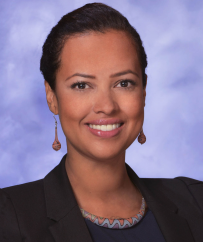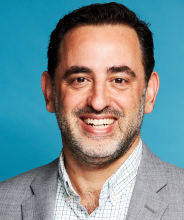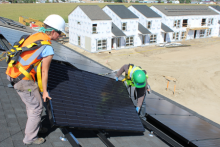Despite low costs and broad market penetration, solar power remains unattainable for many low-income and underserved communities throughout the nation. In Los Angeles, Executive Director of GRID Alternatives Greater Los Angeles Michael Kadish and new LADWP Commissioner Aura Vasquez are championing the effort to bring solar energy—along with the economic development opportunity it can bring—to the city’s 1.6 million renters in multifamily housing. In this TPR interview, they demonstrate how their integrated model could help the city achieve its goals for affordable housing, workforce development, and sustainability.

Aura Vasquez
Integrating energy efficiency with solar, electric vehicle infrastructure, and incentives could bring real benefits to L.A.’s low-income and disadvantaged communities. —Aura Vasquez
Michael, what are GRID Alternatives’ priority goals in terms of integrating renewable energy, housing affordability, and workforce development?
Michael Kadish: GRID Alternatives’ mission is to bring the benefits of solar—both on-bill reductions and access to jobs in the solar industry—to underserved communities. Multifamily affordable housing fits into this mission dead-on.
Los Angeles is a city of renters. More than 1.6 million people, and 46 percent of LADWP customers, live in multifamily apartment buildings with at least five units. Tenants are a huge part of our city, and they’re suffering under higher rents than ever.
When GRID Alternatives started working in Los Angeles County, we worked primarily with low-income homeowners in single-family homes. But, since the median household income of renters is less than half that of homeowners, we’ve realized that our mission demands that we serve tenants in multifamily housing. Moving into multifamily is also another way to expand our job training program, so that residents can participate in the growing solar economy that is going to be a key driver for our city in the decades ahead.
Speak to the importance for Los Angeles of the report that you recently co-authored with the UCLA Luskin Center, Golden Opportunity: Affordable Housing in the Solar Metropolis.
Michael Kadish: When we decided to move into multifamily, we teamed up with UCLA to get a sense of the lay of the land—the challenges and opportunities. At the same time, we did pilot projects in Lancaster and Santa Ana, and we’re scheduled to start our first multifamily work in the city of L.A. in January.
We learned through writing the report that the Low-Income Weatherization Program (LIWP)—a solar installation program through the California Climate Investments fund—could bring $7.3 million in annual savings to renters in affordable housing in LADWP’s service area. It has the potential to bring more than $139 million in investments to the city of Los Angeles through state rebates starting in 2018. This program was set up specifically to benefit renters in disadvantaged communities, so it’s a huge opportunity to bring solar to the parts of L.A. that need it the most.
LADWP has identified 53 zip codes within its service area with low penetration of solar. Within these areas, we’ve identified 26 megawatts of affordable housing solar potential—24 of which lie in areas designated by the state as environmentally disadvantaged, and therefore qualify for the LIWP rebate. This is a key way to bring funds to Los Angeles to expand solar access within communities that could really use its benefits.

Commissioner Vasquez, you prioritized climate justice well before joining the LADWP Board in May, especially in your work with the Center for Popular Democracy. Elaborate on your priorities as a newly appointed DWP commissioner.
Aura Vasquez: It’s very exciting to be a DWP commissioner today, because I now have the opportunity to champion some of the issues I’ve always focused on. I’m committed to bringing renewables to the people who are most affected by pollution, by climate change, and, importantly, by utility rate increases.
We already have a community solar program, and my plan is to extend it to reach more renters and folks in affordable housing—particularly those who receive Section 8 or who are in assisted housing. I’m also committed to increasing access to electric vehicle infrastructure.
Another issue I hope to champion at DWP is energy efficiency. As they say, the cleanest energy is the energy we don’t consume. Integrating energy efficiency with solar, electric vehicle infrastructure, and incentives could bring real benefits to L.A.’s low-income and disadvantaged communities.
Speak to the potential impact of virtual net energy metering as a way to better integrate renewables and energy efficiency with affordable housing.
Aura Vasquez: Our low-income customers deserve 21st century infrastructure that allows them to receive the benefits of renewable energy. To provide that, we are going to need smart meters that accommodate virtual net metering through a seamless and streamlined program.
In 2016, DWP provided over 29 percent of renewable energy to the city of Los Angeles. The opportunity here is for renters to participate beyond the baseline renewable energy that DWP provides. Virtual net metering will allow DWP to further our renewable energy penetration and reach more citizens of L.A.—not only renters, but also commercial tenants and others who may not be able to participate in our traditional solar incentives. It will also empower DWP to credit shared solar programs to participants on their actual participation each month. This is a big issue, because today, it’s hard for renters to know whether their energy is coming from renewables.
Michael Kadish: Virtual net metering increases access to renewable energy because it is not dependent on a system being metered to a particular home. In other words, it allows people to benefit from solar energy without having an array installed on their roof. This overcomes existing limitations to solar posed by the size or quality of a roof, and opens the door to creative programs to distribute the benefits of solar energy more widely.
Los Angeles has a great sustainability plan that prioritizes expanding access, and this is a critically important piece of making that happen. Virtual net metering is not some pie-in-the-sky bold experiment. It’s actually operational in a lot of utilities around the country. L.A. tenants deserve to have it, too—and they really stand to benefit from it, with $7.3 million in potential annual benefits to low-income renters.
Incidentally, the state money that goes through LIWP for virtual net metering can also help affordable housing operators who invest in solar. By utilizing the higher rebate levels that come with virtual net metering, they could take advantage of up to $139 million—which, given the thin margins of a lot of non-profit housing corporations, is a very important amount of money.
Commissioner, what is the potential for LADWP to unlock state dollars for a virtual net metering program or other grid upgrades?
Aura Vasquez: We have the willingness of the Board of Commissioners and our general manager on our side, as well as Mayor Garcetti’s guidelines on access. The big question now is how to institute a program like this without affecting ratepayers’ pockets. We want Angelenos to know that this program is not going to require them to bear the costs of other folks’ energy usage.
One option is a pilot program in which LADWP would utilize state funding from cap-and-trade and other programs to work with existing affordable housing in target areas we have identified as most vulnerable. We can also leverage some of the state’s existing mandates that require affordable housing to be retrofitted for energy efficiency and solar readiness.
We can definitely do it—we just need to figure out how to balance the budget without affecting rates as we do so.
Michael, let’s follow up on GRID Alternatives’ priorities. What is your approach to growing a 21st century workforce for the clean economy?
Michael Kadish: Over the last decade, GRID Alternatives has transformed from a Habitat for Humanity model—relying on volunteers—into a workforce development organization. People come to us from community colleges such as LA Trade Tech, or job training programs such as Homeboy Industries, to get real-world skills from real installs for real families on real roofs. We have a proven track record of training people in communities where the need is high and placing them into jobs. This year, we’ve placed 84 of our Los Angeles trainees into jobs in the solar industry—not just in installation, but also in solar design, project management, sales, and more.
We also have a track record of sending GRID trainees to sit for the exam with IBEW and begin formal apprenticeships. We are a terrific feeder into that program. That’s important, because LADWP’s feed-in tariff program generates a lot of commercial-scale solar installations, and a lot of the jobs on those projects are union jobs. As solar grows, even more of the market in Los Angeles is going to be at the commercial scale.
Our report shows that, if affordable housing operators in the city of Los Angeles maximized the state funds available to them, we could create 2,700 job-training opportunities in the solar industry. This is a huge opportunity for disadvantaged communities, not only to increase solar installation, but also to expand opportunity to get training for a productive green career pathway.
This is all part of building an economy in Los Angeles that works for everyone, and helping to reduce the big gap here between the haves and the have-nots. We want to make sure that unlike, say, the tech economy, the clean energy economy is an intentionally inclusive movement from the get-go.
What best practices could LADWP apply from other jurisdictions around the country to lead on environmental equity?
Aura Vasquez: L.A. is a national leader on environmental and equity issues; our mayor is viewed around the country as a leader on climate and access. But we also have one of the worst air qualities in the country. In this case, it makes sense for us to follow the lead of other places—and potentially, take it a step further and create partnerships with organizations like GRID Alternatives.
Being the second largest city in the country, we set the trend. When we do something, the rest of the country follows. Now, we have the opportunity to create savings, modern infrastructure, and economic benefits for folks in affordable housing. That is an opportunity to leave an incredible legacy, not only for Angelenos, but for the whole country.
Michael Kadish: With the leadership of LADWP and Mayor Garcetti, Los Angeles is integrating equity with sustainability as it never has before. There are several models we could replicate here to help achieve our goals. For example, GRID’s office in Colorado just completed a two-megawatt community solar project, bringing a 50 percent bill reduction to hundreds of low-income families. By partnering with the utility, they were able to bring on market-rate off-takers to ensure the stability of the program for low-income participants. That is an example of a pilot that might make sense here.
Commissioner, before we conclude, elaborate on the EV Business Plan that LADWP plans to adopt in the coming months.
Aura Vasquez: This is very exciting. We want to deploy more than 10,000 commercial EV chargers within the city of Los Angeles over the next five years. The goal is for 4,000 to be on city-owned property, including the Port of Los Angeles as well as in parks and on parking meters. We’ve also allocated $21.5 million to continue making EV charging rebates available to people who need them.
Also, to support the increase in electricity loads, we are targeting distribution infrastructure upgrades to specific locations paired with EV chargers—for example, through heavy-duty equipment at the Port of LA, and EV buses at LA Metro.
Those are some of the things we are already doing. But I have my eye on the bigger prize: I want to see an EV charging station on every street in Los Angeles. People can only make the transition to EVs if we provide them with infrastructure that makes sense.

Michael, if we were to speak again in a year, what progress would you hope to see on connecting the dots between affordable housing and renewable energy?
Michael Kadish: In the first quarter of next year, I would love to see a virtual net metering pilot underway at LADWP—and by the end of 2018, I’d love to see that program expand to the entire rental population of the city. I’d also love to see LADWP continue to innovate around community solar, which has the greatest potential to reach L.A.’s renters.
Spurred by our housing crisis, this city is about to build more affordable housing than ever before. We need to integrate solar into that effort in a smart way that sets up future generations for success—keeping housing operating costs low and tenants’ utility payments modest. If we can do that, then we can live in an L.A. that has cleaner air, more equity, and better jobs.
- Log in to post comments



